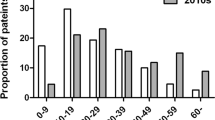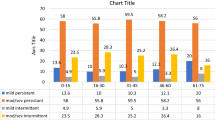Summary
Background
Bronchial hyperresponsiveness (BHR) is a key feature of asthma, but it may also appear in allergic rhinitis. The type of allergen, as well as regional characteristics, play an important role in the development of BHR. The aim of our study was to analyze allergen sensitization patterns and the factors that affect BHR in allergic rhinitis patients living in temperate continental climate zone.
Methods
This study retrospectively analyzed allergic rhinitis patients from Eastern Slovakia who underwent skin-prick tests to aeroallergens, spirometry, histamine and methacholine bronchial provocation tests for evaluation of lower airway symptoms. We analyzed the associations between BHR and the pattern of aeroallergen sensitization, lung function parameters, and the total IgE and eosinophil levels.
Results
Out of 365 allergic rhinitis patients (age range 16–64 years), 114 showed BHR. Sensitization to house dust mites (HDMs) and grass were the most common. BHR was significantly associated with sensitization to dogs (odds ratio, OR = 2.15, 95% confidence interval, CI: 1.13–4.11) and Alternaria (OR = 2.15, 95% CI: 1.06–4.35); however, BHR did not show a relationship with HDMs sensitization. The levels of total IgE and eosinophils were higher in the BHR-positive group. Sensitization to more than six allergens significantly increased the probability of BHR (p < 0.01).
Conclusion
Dogs and Alternaria, but not HDMs, were the sensitizing agents most closely associated with BHR. High-grade sensitization and increased total IgE and eosinophil levels were characteristic clinical signs in BHR-positive allergic rhinitis patients in the temperate continental climatic zone.
Similar content being viewed by others
References
Backman H, Räisänen P, Hedman L, Stridsman C, Andersson M, Lindberg A, Lundbäck B, Rönmark E. Increased prevalence of allergic asthma from 1996 to 2006 and further to 2016—results from three population surveys. Clin Exp Allergy. 2017;47:1426–35.
Bousquet J, Van Cauwenberge P, Khaltaev N, Aria Workshop Group, World Health Organization. Allergic rhinitis and its impact on asthma. J Allergy Clin Immunol. 2001;108(5):S147–S334.
Brożek JL, Bousquet J, Agache I, et al. Allergic rhinitis and its impact on asthma (ARIA) guidelines—2016 revision. J Allergy Clin Immunol. 2017;140(4):950–8.
Burte E, Bousquet J, Siroux V, Just J, Jacquemin B, Nadif R. The sensitization pattern differs according to rhinitis and asthma multimorbidity in adults: the EGEA study. Clin Exp Allergy. 2017;47(4):520–9.
Wang W, Xian M, Xie Y, Zheng J, Li J. Aggravation of airway inflammation and hyper-responsiveness following nasal challenge with dermatophagoides pteronyssinus in perennial allergic rhinitis without symptoms of asthma. Allergy. 2016;71:378–86.
Yii ACA, Tay TR, Choo XN, Koh MSY, Tee AKH, Wang DY. Precision medicine in united airways disease: a “treatable traits” approach. Allergy. 2018;73:1964–78.
Karakioulaki M, Papakonstantinou E, Goulas A, Stolz D. The role of atopy in COPD and asthma. Front Med (Lausanne). 2021;8:674742.
Jo EJ, Eom JS, Mok J, et al. Patterns of sensitization to aeroallergens and their effect on airway hyper-responsiveness in Busan, Korea. Asian Pac J Allergy Immunol. 2021;39(3):182–9.
Pesce G, Bugiani M, Marcon A, et al. Geo-climatic heterogeneity in self-reported asthma, allergic rhinitis and chronic bronchitis in Italy. Sci Total Environ. 2016;544:645–52.
Charpin D, Ramadour M, Lavaud F, et al. Climate and allergic sensitization to airborne allergens in the general population: data from the French six cities study. Int Arch Allergy Immunol. 2017;172(4):236–41.
Shoormasti RS, Sabetkish N, Kazemnejad A, et al. A meta-analysis of sensitization to the most common aeroallergens in a Middle Eastern region: an overview of the main molecular allergens. Aerobiologia. 2019;35:383–409.
Lok SD, Davis BE, Cockcroft DW. Prevalence of allergen sensitization in 1000 adults in Saskatchewan. Allergy Asthma Clin Immunol. 2017;13:9.
Warm K, Hedman L, Lindberg A, Lötvall J, Lundbäck B, Rönmark E. Allergic sensitization is age-dependently associated with rhinitis, but less so with asthma. J Allergy Clin Immunol. 2015;136:1559–65.
Agache I, Cezmi AA. Precision medicine and phenotypes, endotypes, genotypes, regiotypes, and theratypes of allergic diseases. J Clin Invest. 2019;129(4):1493–503.
Valero A, Quirce S, Davila I, Delgado J, Domínguez-Ortega J. Allergic respiratory disease: different allergens; different symptoms. Allergy. 2017;72:1306–16.
D’Amato G, Cecchi L, Bonini S, et al. Allergenic pollen and pollen allergy in Europe. Allergy. 2007;62:976–90.
https://www.weatheronline.co.uk/reports/climate/Slovakia.htm. Accessed 30 Oct 2020.
Slovak Hydrometeorological Institute. Climatic conditions of the Slovak Republic. http://www.shmu.sk/sk/?page=1064. Accessed 25 Nov 2020.
Quanjer PH, Tammeling GJ, Cotes JE, Pedersen OF, Peslin R, Yernault JC. Lung volumes and forced ventilatory flows. Report working party standardization of lung function tests; European community for steel and coal. Official statement of the European respiratory society. Eur Respir J Suppl. 1993;16:5–40.
Kim BS, Jin HS, Kim HB, et al. Airway hyperresponsiveness is associated with total serum immunoglobulin E and sensitization to aeroallergens in Korean adolescents. Pediatr Pulmonol. 2010;45:1220–7.
Newson RB, van Ree R, Forsberg B, et al. Geographical variation in the prevalence of sensitization to common aeroallergens in adults: the GA2 LEN survey. Allergy. 2014;69:643–51.
Bousquet PJ, Chinn S, Janson C, et al. Geographical variation in the prevalence of positive skin tests to environmental aeroallergens in the European community respiratory health survey I. Allergy. 2007;62(3):301–9.
Arlian LG, Neal JS, Vyszenski-Moher DL. Reducing relative humidity to control the house dust mite dermatophagoides farinae. J Allergy Clin Immunol. 1999;104:852–6.
Konradsen JR, Fujisawa T, van Hage M, et al. Allergy to furry animals: new insights, diagnostic approaches, and challenges. J Allergy Clin Immunol. 2015;135(3):616–25.
Toppila-Salmi S, Huhtala H, Karjalainen J, et al. Sensitization pattern affects the asthma risk in Finnish adult population. Allergy. 2015;70:1112–20.
Haarala AK, Sinikumpu SP, Vaaramo E, et al. Incidence and remission of aeroallergen sensitization in adults in Northern Finland: 15 years longitudinal study. Sci Rep. 2021;11(1):4249.
Peat JK, Tovey E, Mellis CM, Leeder SR, Woolcock AJ. Importance of house dust mite and alternaria allergens in childhood asthma: an epidemiological study in two climatic regions of Australia. Clin Exp Allergy. 1993;23(10):812–20.
Resch Y, Michel S, Kabesch M, Lupinek C, Valenta R, Vrtala S. Different IgE recognition of mite allergen components in asthmatic and nonasthmatic children. J Allergy Clin Immunol. 2015;136(4):1083–91.
Plaschke P, Janson Ch, Norrman E, Bjornsson E, Ellbjar S, Jarvholm B. Association between atopic sensitization and asthma and bronchial hyperresponsiveness in Swedish adults: pets, and not mites, are the most important allergens. J Allergy Clin Immunol. 1999;103:58–65.
Patelis A, Dosanjh A, Gunnbjörnsdottir M, et al. New data analysis in a population study raises the hypothesis that particle size contributes to the pro-asthmatic potential of small pet animal allergens. Ups J Med Sci. 2016;121(1):25–32.
Perzanowski MS, Ronmark E, James HR, et al. Relevance of specific IgE antibody titer to the prevalence, severity, and persistence of asthma among 19-year-olds in northern Sweden. J Allergy Clin Immunol. 2016;138(6):1582–90.
Zahradnik E, Raulf M. Animal allergens and their presence in the environment. Front Immunol. 2014;5:76.
Jung JW, Choi JC, Shin JW, Kim JY, Park IW, Choi BW. Clinical characteristics according to sensitized allergens in adult Korean patients with bronchial asthma. Allergy Asthma Immunol Res. 2010;2:102–7.
Hernandez-Ramirez G, Barber D, Tome-Amat J, Garrido-Arandia M, Diaz-Perales A. Alternaria as an inducer of allergic sensitization. J Fungi (Basel). 2021;7(10):838.
Burbach GJ, Heinzerling LM, Edenharter G, et al. GA(2)LEN skin test study II: clinical relevance of inhalant allergen sensitizations in Europe. Allergy. 2009;64(10):1507–15.
Mete N, Sin A, Gulbahar O, Erdinc M, Sebik F, Kokuludag A. The determinants of bronchial hyperresponsiveness in patients with allergic rhinitis. Ann Allergy Asthma Immunol. 2004;93(2):193–9.
Florincescu-Gheorghe NA, Popescu F, Alexandru DO, Popescu FD. The prevalence of allergic rhinitis to ambrosia elatior in oltenia area and the association with allergic conjunctivitis or asthma. Curr Health Sci J. 2019;45(1):66–72.
Lipiec A, Sybilski A, Rapiejko P, et al. Prevalence of allergic rhinitis and asthma in Poland in relation to pollen counts. Postepy Dermatol Alergol. 2020;37(4):540–7.
Kosturiak R. Skin tests in patients in and around Nitra and their relationship to asthma. Clin Immunol Allergol. 2020;30(1):6–12. article in Slovak langue.
Author information
Authors and Affiliations
Corresponding author
Ethics declarations
Conflict of interest
S. Perečinský, L. Murínová, A. Jančová, P. Murín, K. Perečinská, M. Varga, B. Víchová, E. Pačuta, M. Rašiová and Ľ. Legáth declare that they have no competing interests.
Additional information
Publisher’s Note
Springer Nature remains neutral with regard to jurisdictional claims in published maps and institutional affiliations.
Rights and permissions
About this article
Cite this article
Perečinský, S., Murínová, L., Jančová, A. et al. Allergic sensitization pattern as a marker of bronchial hyperresponsiveness in allergic rhinitis patients living in temperate continental climate zone. Wien Klin Wochenschr 134, 766–771 (2022). https://doi.org/10.1007/s00508-022-02081-4
Received:
Accepted:
Published:
Issue Date:
DOI: https://doi.org/10.1007/s00508-022-02081-4




